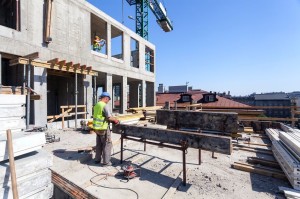As the name suggests, we have various engineers on staff here at McNeil Engineering. The two main types of engineers we employ are civil engineers and structural ones. We thought it might be helpful to dive deeply into the differences between these two types of engineers and why you might need them on a job site! First, civil engineering and structural engineers are two distinct yet related professions within the engineering field. While both types of engineering work deal with the design and construction of buildings, infrastructure, and other structures, the two have significant differences. At McNeil Engineering, we have two separate service pages for civil and structural engineering projects.
Civil engineering is a broad field that encompasses the built environment’s design, construction, and maintenance. Civil engineers work on various projects, from roads and bridges to buildings, airports, and water treatment facilities. They are involved in every project stage, from initial planning and design to construction and maintenance. You can see examples of some of our Civil Engineering Projects here and read exactly what McNeil Engineering did on each site.
On the other hand, structural engineering is a subfield of civil engineering that focuses specifically on the design and analysis of structures. Structural engineers are responsible for ensuring that a building or structure can support the weight it was designed to hold and resist external forces and pressures, such as wind, earthquakes, and fire. Our structural engineers use advanced mathematical and engineering principles to determine the optimal design for a given structure and ensure it is safe and secure. Examples of some of our structural engineering projects are here. We’re pretty proud of these too.
Education and Training
Both civil engineers and structural engineers typically hold a bachelor’s degree in engineering, with a focus on their respective fields and area of expertise. Civil engineers may specialize in transportation, water resources, or environmental engineering. Structural engineers, on the other hand, may want to focus on the design of buildings, bridges, or different types of structures.
In addition to a formal education, civil and structural engineers must be licensed by their state or country to practice professionally. This usually involves passing an exam that covers both theory and practical applications.
Scope of Work
Civil engineers can be involved in various projects, from designing roads and bridges to planning and constructing buildings, water treatment facilities, and airports. To create efficient and effective solutions, they consider various factors, such as environmental impact, zoning laws, and cost constraints. Civil engineers also play a critical role in ensuring that structures are built to last, by developing maintenance plans and conducting regular inspections of buildings and structures.
Structural engineers, on the other hand, focus exclusively on the design and analysis of structures. They use mathematical models and computer simulations to test the strength and stability of a structure and identify areas of potential weakness. They also work closely with architects and contractors to ensure their designs are practical, safe, and feasible. Structural engineers may also be called upon to assess existing structures and recommend repairs or upgrades.
Technical Skills
Civil engineers must have a wide range of technical skills, including proficiency in computer-aided design (CAD) software, project management tools, and engineering analysis software. They must also be familiar with various construction materials, techniques, environmental regulations (local and federal level), and safety codes of multiple buildings and structures.
Structural engineers deeply understand structural mechanics, materials science, and engineering mathematics. They use these skills to create models and simulations that predict the behavior of a structure under different loads and conditions. They must also be able to use specialized software, such as finite element analysis (FEA) tools, to test and refine their designs.
Problem-Solving Approaches
Civil engineers must consider various factors when developing solutions to complex problems. They must balance cost, safety, and environmental impact while considering local regulations and possible cultural sensitivities that might arise during projects. Civil engineers must be creative, adaptable, and able to think outside the box to find innovative solutions to complex problems.
Structural engineers must be highly analytical and precise in their approach to problem-solving. They must be able to analyze complex data and develop mathematical models to predict the behavior of a structure under different loads and conditions. They must also be able to work with architects and contractors to integrate their designs into the overall project plan.
We hope this has helped you understand some similarities and differences between civil and structural engineers. Here at McNeil Engineering, we’re proud to employ both. That means we work on projects that incorporate civil and structural engineering and are experts in both domains. If you could benefit from our civil or structural engineers, Visit us here and contact a team member today. We’d be happy to discuss an upcoming project for any of our services.









